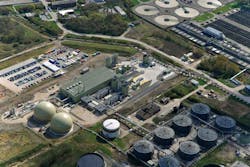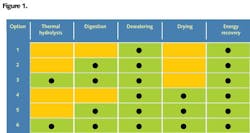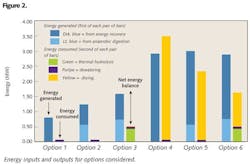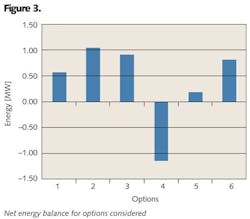Thermal Hydrolysis: The Missing Ingredient for Better Biosolids?
One of the world's largest facilities in Davyhulme is proving the importance of thermal hydrolysis technology combined with digestion prior to sludge incineration. Bill Barber, Rick Lancaster and Harald Kleiven discuss reasons for the technology choice and results from an energy study measuring inputs and outputs.
The quantity of sewage sludge, an inevitable by-product of wastewater treatment, is increasing worldwide. This rise is fuelled by a combination of a growing and increasingly urbanized population especially in Far East Asia, and increasingly strict environmental legislation. Once treated, sewage sludge becomes a valuable source of nutrients, known as biosolids, which is used in a number of outlets. Numerous studies have shown that the use of biosolids as a fertilizer on agricultural land to exploit its nutrient and other valuable soil conditioning properties is the most environmentally sustainable and appropriate use for the product.
However, there are a number of instances where land application of biosolids in this way is not an available option. These instances may include: legislation preventing its use; high population density coupled with low land availability; presence of organic or metal contaminants, and public perception issues resulting in alternative outlets to minimize business risk. In these instances, biosolids are typically used in various energy recovery systems to take advantage of their inherent energy content, which for dried biosolids, is equivalent to lignite.
Energy recovery systems may include: incineration; co-firing; gasification; pyrolysis or super- and sub-critical wet air oxidation. However, the quantity of energy which can be recovered is a function of the type of sludge and treatment it receives on the sewage treatment works.
Prior to energy recovery, energy can be extracted from sludge upstream by processing it via anaerobic digestion. This produces a methane-enriched biogas which can be converted to electricity and heat using co-generation, or converted into biomethane which acts as a substitute for natural gas. Typically, anaerobic digestion of 10,000 (TDSA) dry solids per annum (based on European data) produces between 0.5 and 1.0 MW electricity depending on sludge type.
In addition, a number of pre-treatment processes can be used in conjunction with anaerobic digestion to further enhance energy recovery from biogas. A popular well-established process is known as thermal hydrolysis. Thermal hydrolysis is a two-stage process combining pressure cooking followed by a rapid decompression. This combined action sterilizes the sludge and makes it more biodegradable which improves digestion performance. Sterilization destroys pathogens in the sludge resulting in it exceeding the most stringent requirements for land application.
In addition, thermal treatment adjusts the rheology to such an extent that loading rates to municipal sewage sludge anaerobic digesters can be doubled, and also dewaterability of the sludge is significantly improved. The first full-scale application of this process for sewage sludge was for the city of Hias in Norway provided by Cambi. Since then, there have been over 30 additional installations globally.
Thermal hydrolysis was central to the implementation of UK water company United Utilities' sludge strategy, which was announced in 2009. The strategy was based on providing maximum flexibility by enabling a combination of biosolids recycling to land or burning for energy recovery or both depending on fluctuating current and future drivers and legislation.
In order to execute the strategy, a thermal hydrolysis plant (at the time, the world's largest) was installed at Davyhulme, Manchester. Davyhulme is one of several anaerobic treatment plants which feed an 80 km pipeline initially installed to pump sludge across the region before it was loaded into ships and ultimately disposed at sea before that outlet was banned in 1998.
In response to the ban, United Utilities built the Mersey Valley Processing Centre (MVPC) on the pipeline which involved dewatering (of the piped liquid digested sludge) followed by land application or incineration. United Utilities built on this capability, formulating a strategy in 2002 to reduce its reliance on land application from 70% to 40% partly by upgrading capacity at the MVPC in response to increasing pressures on land recycling. The facility's capacity was increased from approximately 30,000 tonnes dry solids per annum (TDSA) to 75,000 digested TDSA. In addition, a new raw sludge incineration plant was planned for Lancashire to treat 52,000 TDSA of raw sludge which was previously limed.
During the implementation of this strategy extensive work by the project team and fluctuating drivers started to question the necessity of the second incineration plant. Burning raw sludge (assumed better due to higher calorific value) required significant contingency arrangements to be put in place during planned statutory shutdowns. This was due to the need to manage the sludge via recycling on an intermittent basis. In addition, a growing awareness of the energy potential in the sludge and the associated carbon footprint benefits was being gained by United Utilities.
The project team completed detailed mass and energy balances to articulate the advantages of first anaerobically digesting the biosolids prior to burning with respect to energy recovery, contingency planning and carbon footprint. Although the digested biosolids would generate less energy at the incineration plant, work showed that more energy would be recovered in the overall system when combined with the energy generated from biogas in the digestion facility.
In addition, the incineration throughput is reduced, allowing the strategy to be delivered by the delivery of the MVPC improvements. After detailed analysis of a number of variations of digestion followed by incineration, it was decided that a combination of thermal hydrolysis followed by digestion followed by incineration was the most sustainable option.
Ideally, this would be achieved by maximizing use of existing assets. Therefore, studies were conducted to determine if the existing digestion facility in Davyhulme could take the additional load of Lancashire sludge. Laboratory experimentation was undertaken to investigate the impact of thermal hydrolysis on dewatering and calorific value prior to energy recovery.
Studies showed that the calorific value of thermally hydrolysed and digested sludge was actually higher than sludge, which was only digested and this was due to the significant improvement in dewaterability.
The additional energy in the sludge meant that the existing incinerator could burn more sludge than it was originally designed for. As thermal hydrolysis affords a doubling in digestion throughput it was possible to feed all the Lancashire sludge into the Davyhulme plant without the need for additional digestion infrastructure.
As a result, in 2009, a contract was awarded to Black and Veatch for the installation of a Cambi™ thermal hydrolysis plant capable of treating an average feed of 91,000 TDSA (approximately 52,000 from Lancashire plus 39,000 from Davyhulme) with an installed capacity of 121,000 TDSA.
The contract includes installation of new co-generation engines and refurbishment work to the energy plant, which now has an installed capacity of approximately 12MWe. A new dewatering plant, based on centrifuges allows dewatering and recycling as an enhanced treated pathogen-free cake from Davyhulme.
Alternatively, the digested liquid can be pumped in the pipeline as before to the MVPC where it can be dewatered and recycled as a standard treated biosolids cake (quality downgraded due to coming into contact with digested sludge from other facilities attached to the pipeline), or burnt in the existing incineration facility. These outlets are not mutually exclusive. The two processes treat approximately 60% of the sludge produced by the seven million people who live in the North West of England. The project was found to:
• Reduce carbon footprint from existing scenario
• Maximize existing asset use
• Significantly increase renewable energy generation
• Improve biosolids quality enabling land recycling to new outlets
• Minimize incineration requirements
• Enable maximum flexibility
The construction work at the Davyhulme facility and the seven dewatered sludge cake feeder sites spread across the North West of England has been completed. The Thermal Hydrolysis process is due to be commissioned on sludge in October 2012.
Commissioning will be sectional as there are four streams of Thermal Hydrolysis at Davyhulme, each capable of processing 30,000 TDSA.
The project above has highlighted the importance of thermal hydrolysis combined with digestion prior to incineration, but a number of other variations are possible.
A study was conducted based on some of the findings at Davyhulme to measure the major energy inputs and outputs of the following variations where process steps are either included (green) or excluded (purple), seen in figure 1 below. The baseline for calculation was 10,000 tonnes dry solids processed per year.
The main energy flows are also shown in the Figure 2 below. In order to appreciate the total energy requirements, it is necessary to compare the difference between energy recovered and consumed, i.e. the difference between the first and second of each pair of bars in the chart. This data is shown below.
Looking at the figures, when recovering energy from dewatered cake, overall energy recovery is far better when anaerobic digestion is included in spite of the cake having lower calorific value. This is due to the higher energy recovery efficiency during cogeneration than compared with burning.
Although the use of thermal hydrolysis with anaerobic digestion increases energy demand compared with use of anaerobic digestion alone (Davyhulme scenario), the net energy balance is similar due to increased energy generation in the energy recovery plant as a result of superior dewaterability.
When considering options involving drying (Options 4, 5 and 6) anaerobic digestion significantly enhances the energy balance compared to when digestion is absent (Option 4).
In that case, the energy balance is lower than -1 MW consumed per 10,000 tonnes dry solids of sludge processed. If drying is considered prior to energy recovery off-site, installation of thermal hydrolysis results in the most favourable energy balance.
Although energy consumption is higher compared to digestion alone, the drying requirements are fundamentally reduced. This is due to a combination of enhanced digestion performance (less quantity to dry) compared to better dewaterability (less water to evaporate).
In this instance, installation of thermal hydrolysis reduces dryer energy demands by half when compared to anaerobic digestion where thermal hydrolysis is absent, and by two thirds when no anaerobic digestion is considered.
Author note: Bill Barber is formerly of United Utilities, Rick Lancaster is the sludge balanced asset programme operational readiness manager of United Utilities and Harald Kleiven is from Cambi.




